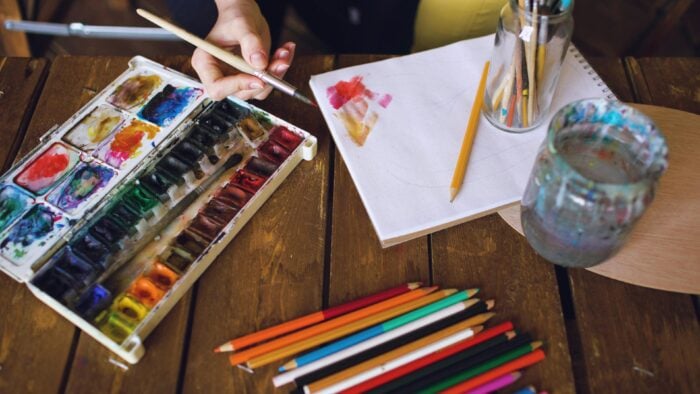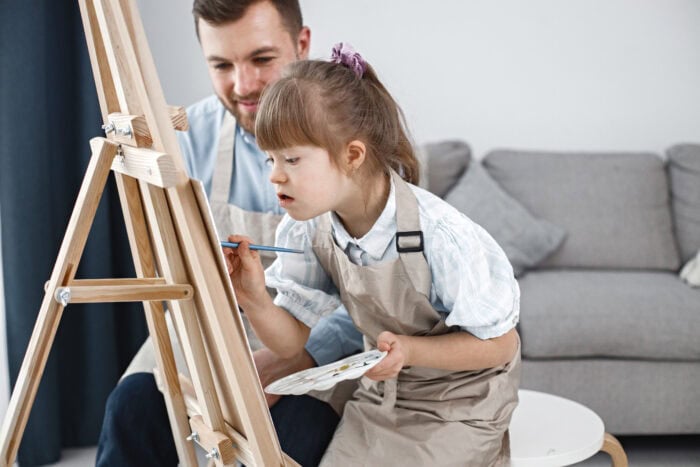Do you find it easier to express your feelings through drawing instead of with words? Do you enjoy helping other people? Then art therapy might be just right for you!
WHAT IS ART THERAPY?
Art therapy is a relatively young method that uses creative media such as painting, drawing, crafting, or photography to express feelings and thoughts. A therapist helps to guide and support these forms of expression. Art therapy combines art with psychology and education and is often used for mental health issues or in healthcare to help people feel better and improve their perception.
WHAT HAPPENS IN AN ART THERAPY DEGREE PROGRAM?
You combine artistic skills with psychological and therapeutic knowledge to support people in coping with mental or physical problems.) You will learn both practical methods and theoretical foundations from art, psychology, and medicine. So, the psychological part is significant, but it is always linked to artistic methods. The Bachelor’s degree lasts 6–8 semesters and ends with a Bachelor’s thesis; the Master’s degree takes 2–4 semesters and ends with a Master’s thesis.
WHERE CAN YOU STUDY ART THERAPY?
There are several universities and academies in Germany that offer art therapy. Depending on the university, the programs may focus on different aspects, such as practical art techniques, psychological fundamentals, or the therapeutic application of art. Furthermore, you can find a list of these universities here: List of universities for art therapy in Germany

WHAT REQUIREMENTS SHOULD I MEET?
For the Bachelor’s degree, you need a university entrance qualification and an art portfolio. Often also an admission interview or something similar. The Master’s degree requires a Bachelor’s in art therapy. In the Master’s program, you go deeper into research and project management. You should also be artistically experienced, empathetic, communicative, and patient, since you work with people who need support with personal challenges.
WHAT DOES THE DAILY ROUTINE IN MY FUTURE JOB LOOK LIKE?
As an art therapist, you will prepare materials, conduct sessions with individuals or groups, have conversations and document them, and exchange ideas with the team. If you are self-employed, you’ll also handle appointments, organization, and billing. Both are possible! Many start out employed in a clinic or a social institution. Later, some become self-employed with their own practice, workshops, and projects. You will work with a wide variety of people, e.g., children, adolescents, adults with psychological problems, people with disabilities or dementia, but also patients in rehab or palliative care.

In a session, a client might paint a picture that represents their fears, for example, using chaotic lines and dark colors. As an art therapist, with your artistic understanding, you help choose the appropriate materials and reflect together with the client on what these symbols say about their inner conflicts and feelings.
The average salary is between €33,000 and €60,000 gross per year. In self-employment, it depends on how many clients you have and what hourly rate you charge.
PURPOSE OF ART THERAPY
By creating images, clients can reduce anxiety, grief, and stress. The creative process promotes self-confidence and supports trauma processing by opening up new perspectives on problems. When words are no longer enough, art can be a valuable tool to open up, heal, and grow. Find out more about creative relaxation and art as a profession here:
Becoming an artist- is art still recognized as a career today?
Do you listen to music while drawing? – The connection between art and music
Sources:
https://www.medi-karriere.de/medizinische-berufe/kunsttherapeut/
https://www.gehalt.de/beruf/kunsttherapeut
https://www.studycheck.de/studium/kunsttherapie
https://de.wikipedia.org/wiki/Kunsttherapie
https://www.azubiyo.de/dual-studieren/studiengaenge/kunsttherapie/
Sara Wierlacher